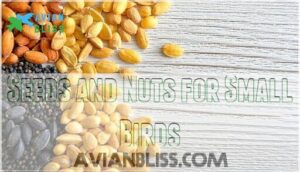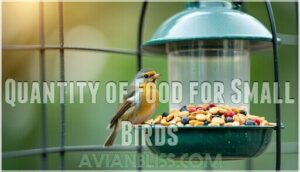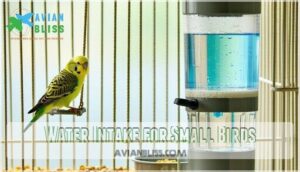This site is supported by our readers. We may earn a commission, at no cost to you, if you purchase through links.

A mix of high-quality seeds and pellets works great, offering essential nutrients for energy and feather health.
Small birds also love fresh fruits like apples or berries (in moderation) and veggies such as spinach or carrots, adding variety and vital vitamins.
Avoid avocado, chocolate, or anything salty—they’re toxic to birds.
Switch out food daily to keep it fresh, and always offer clean water.
Birds need a little routine but also some spice—watch for their preferences.
Curious about providing a diet that keeps them chirpy all day long?
Table Of Contents
- Key Takeaways
- Small Bird Food Options
- Feeding Small Birds
- Top 10 Small Bird Foods
- 1. Clear Bird Cage Food Containers
- 2. Automatic Bird Feeder Water Dispenser
- 3. Bird Water Dispenser Feeder Set
- 4. Bird Cage Food Bowl Holders
- 5. Clear Bird Feeders And Waterers
- 6. Automatic Bird Feeder Dispenser Container
- 7. Automatic Bird Feeder Seed Catcher
- 8. Automatic Bird Feeder Dispenser System
- 9. Automatic Parrot Seed Feeders System
- 10. Automatic Bird Feeder Seed Container
- Choosing Bird Food
- Healthy Bird Environment
- Frequently Asked Questions (FAQs)
- What do you put in a caged bird feeder?
- What bird feeder is best for small birds?
- How do you feed only small birds?
- What is the best thing to put in the bottom of a bird cage?
- What can I feed small birds?
- What should I put on the floor of my bird cage?
- How often should I feed small birds?
- Can small birds eat human food safely?
- Are there seasonal foods for small birds?
- How to introduce new food to birds?
- Conclusion
Key Takeaways
- Mix seeds, pellets, fresh fruits, and veggies to keep your bird’s diet balanced and nutritious.
- Avoid toxic foods like avocado, chocolate, onion, or garlic, and always offer fresh, clean water daily.
- Feed small portions twice a day and replace uneaten food to maintain freshness and prevent waste.
- Use bird-friendly feeders, liners, and toys to create a stimulating and clean cage environment.
Small Bird Food Options
You’ve got plenty of choices regarding feeding your small feathered friends a healthy diet.
From seeds and pellets to fresh fruits and vegetables, it’s all about finding the right balance for their unique needs.
Seeds and Nuts for Small Birds
Seeds and nuts make excellent small bird food when offered as healthy treats.
Seeds and nuts are perfect treats for small birds, adding variety and nutrition to their diet when offered in moderation.
Millet seeds, sunflower seeds, and Nyger seeds are nutrient-rich favorites for bird nutrition, while tiny nuts like flax or chia pack extra benefits.
Small seeds are easy for birds to eat and digest, but remember: variety is key for balanced bird diets.
Keep it fresh! For ideal nutrition, understanding small bird seed options is essential for a healthy diet.
Pellets for Small Birds
Pellets are a powerhouse for small bird nutrition, offering balanced nutrients in every bite.
Unlike seed-heavy diets, bird pellets prevent picky eating and deliver essential vitamins and minerals.
With options like Zupreem and Roudybush, you’ll find sizes and flavors to fit any bird’s palate.
For any cage bird diet, pellets guarantee your pet bird food supports health and energy daily.
Choosing the right pellets involves considering organic food options to provide a well-rounded diet for your small bird.
Fresh Fruits and Vegetables for Small Birds
Adding fresh produce to your pet bird’s diet is essential for small bird nutrition.
Veggie delights like leafy greens, carrots, and zucchini should be daily staples.
Fruit variety, including apples or papayas, makes excellent healthy snacks in moderation.
Chop veggies and fruits into bird-friendly sizes, this guarantees fresh fruits and vegetables stay a key part of your bird food varieties.
Feeding Small Birds
Feeding small birds requires you to balance portion sizes, feeding frequency, and water availability to keep them healthy.
It’s important to provide fresh food and water daily while monitoring their intake to guarantee their needs are met.
Frequency of Feeding Small Birds
Consistency in feeding schedules helps maintain a bird’s appetite and overall nutrition balance.
Most small birds thrive on frequent meals throughout the day.
Here’s a simple breakdown:
- Morning: Start with fresh food to match their natural feeding habits.
- Midday: Offer a small portion to maintain energy.
- Evening: Serve a lighter meal.
- Fresh Water: Refill during every meal change.
Understanding bird feeding habits basics is essential for providing a healthy diet.
Quantity of Food for Small Birds
Knowing your bird’s appetite is key to setting daily rations.
Small birds usually need about 10-15% of their body weight in food each day.
Spread meals across feeding schedules to match their bird feeding habits.
Offer bird food varieties to guarantee proper nutrition needs are met.
Balanced portions maintain pet bird nutrition, preventing overfeeding or waste in indoor bird feed routines, which is crucial for the bird’s health and well-being, and ensures a balanced diet.
Water Intake for Small Birds
Just as food portions are important, water matters too!
Hydration needs vary, but always make certain fresh, clean water is available.
Birds gulp more when it’s warm, so check often.
Poor water quality can harm bird health.
Use sturdy containers to avoid spills.
Balanced bird nutrition isn’t just pet bird food—it’s fluid intake too, supporting small bird care and daily bird health.
Top 10 Small Bird Foods
You want the best food options to keep your small bird healthy and happy.
Here’s a list of the top 10 small bird foods designed for indoor cages, offering convenience and nutritional balance.
1. Clear Bird Cage Food Containers

Sometimes, the simplest solutions make life easier, like clear bird cage food containers.
These feeders minimize mess with a smart lid design that keeps seeds from flying everywhere.
Made from durable, lightweight polypropylene, they’re easy to clean and let you monitor food levels at a glance.
The included perch adds comfort for your birds while feeding, making it a practical and low-maintenance option for anyone looking to keep their bird’s mealtime tidy and stress-free.
Just check your cage’s measurements to confirm a good fit.
Best For: Bird owners with parakeets, canaries, or other small birds looking for an affordable, mess-free feeding solution.
- Reduces seed waste with a smart lid design.
- Durable and lightweight for easy cleaning and handling.
- Includes a perch for added bird comfort.
- Compatibility with cage openings may vary.
- Hand washing required for longevity.
- Reports of occasional damage or missing parts in shipments.
2. Automatic Bird Feeder Water Dispenser
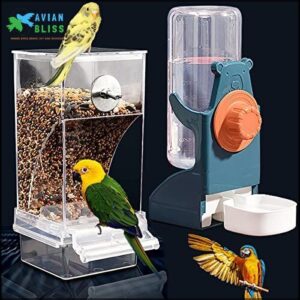
Ever wish feeding your bird was simpler? An automatic bird feeder water dispenser might be your answer.
These feeders provide constant access to fresh food and water, reducing spills and waste. They are designed for convenience, holding up to 500g of seeds and lasting days, perfect for small to medium birds.
Their transparent design helps you monitor supplies, and cleaning is a breeze with removable trays. Whether mounted inside or outside the cage, they’re a hassle-free way to keep your feathered friend happy and hydrated.
Best For: Bird owners with small to medium-sized birds seeking a convenient and low-maintenance feeding solution.
- Not compatible with large seeds, limiting food options.
- Mixed compatibility with some cage types.
- Does not completely eliminate seed mess.
- Gravity-based design ensures continuous food and water supply.
- Transparent construction allows easy monitoring of levels.
- Easy to clean and install, reducing maintenance effort.
3. Bird Water Dispenser Feeder Set

A bird water dispenser feeder set is a convenient choice for keeping your feathered friends hydrated and well-fed.
These sets often feature separate compartments for food and water, making refills easy without opening the cage.
They’re perfect for parakeets, cockatiels, and other small birds, offering ample space for comfortable access.
With durable materials and a see-through design, you can monitor levels at a glance.
Plus, the automatic drink dispensers help minimize mess, ensuring cleanliness and making your daily pet care routine hassle-free.
Best For: Bird owners with small to medium-sized birds like parakeets, cockatiels, and budgies who want a convenient, low-mess feeding solution.
- Separate compartments for food and water make refilling easy.
- Durable materials with see-through design for monitoring levels.
- Automatic drink dispensers reduce mess and maintain cleanliness.
- May not fit cages with narrow bar spacing.
- Thin material in some cases can lead to durability issues.
- Birds might knock over or break the feeder during use.
4. Bird Cage Food Bowl Holders

In the context of keeping your bird’s cage neat and tidy, bird cage food bowl holders are a game-changer.
These stainless steel holders securely attach to cage bars, preventing spills and messes. With detachable brackets, they’re easy to clean and maintain.
Perfect for small birds like parakeets and finches, the bowls hold food or water without tipping. The design keeps feeding stations organized while ensuring safety.
Plus, their durable construction means they last, giving you peace of mind and your bird hassle-free meals.
Best For: Pet owners looking for durable, easy-to-clean food and water bowls that prevent spills and keep their birdcages tidy.
- Limited to a 10 oz capacity, which may not suit larger birds.
- May require proper placement to avoid uneven attachment.
- Only available in a specific size for certain cage types.
- Made from long-lasting stainless steel.
- Detachable brackets for easy cleaning and installation.
- Prevents tipping and messes inside the cage.
5. Clear Bird Feeders And Waterers

Clear bird feeders and waterers are a game-changer for bird lovers.
Their transparent design gives you a front-row seat to your bird’s mealtime, making feeding time more enjoyable for you and your feathered friend.
Many models prevent food buildup with drainage holes, ensuring easy cleanup, and suction cups securely attach them, so no worries about tipping over.
With UV-resistant materials, they’re durable and long-lasting, even in sunny spots, and whether indoors or outside, these feeders keep areas clean while letting you enjoy the view of your birds, making it a great experience with easy cleanup.
Best For: Bird owners looking for mess-free, durable feeders that provide clear visibility and easy maintenance.
- Transparent design offers clear views of feeding birds.
- Anti-splash and anti-spill features reduce mess.
- UV-resistant materials ensure long-lasting use outdoors.
- Cleaning may require manual removal from the cage.
- Not all cage feeders are compatible with the design.
- Some users report difficulty removing the feeder through cage slots.
6. Automatic Bird Feeder Dispenser Container
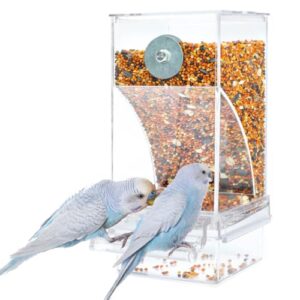
In regards to keeping your bird’s feeding area tidy and efficient, an automatic bird feeder dispenser container is a game changer.
Its clear design lets you easily monitor food levels, while the dustproof feature helps guarantee clean meals.
The gravity-fed mechanism minimizes waste, saving you time and effort. It’s perfect for small to medium birds like parakeets or finches and fits most square cages.
Easy to install and clean, this feeder is ideal for birds known to cause a bit of a mess.
Best For: Bird owners with small to medium-sized birds like parakeets or finches who want a cleaner, low-maintenance feeding solution.
- Clear acrylic design for easy food level monitoring.
- Gravity-fed system reduces waste and saves time.
- Dustproof feature ensures clean and healthy feeding.
- Not compatible with curved or round cages.
- Top cover may not be securely fastened in all situations.
- Drawer removal may cause minor seed spillage.
7. Automatic Bird Feeder Seed Catcher

When feeding small birds indoors, spilled seeds can feel like an unwelcome guest at every meal.
That’s where an automatic bird feeder seed catcher saves the day. By trapping up to 90% of spilled seeds, it keeps your bird’s space cleaner and your floors tidier.
Its extra perching space makes it both practical and inviting for feathered friends. Easy to attach and compatible with most tube feeders, it balances convenience and cleanliness.
Plus, it’s a simple way to protect your garden from rotting seeds below, making it an essential tool for maintaining a clean and tidier environment.
Best For: Individuals looking to keep their bird’s feeding area cleaner and minimize seed waste indoors or outdoors.
- Reduces mess by catching up to 90% of spilled seeds.
- Easy to attach and compatible with most tube bird feeders.
- Provides extra perching space, enhancing bird comfort.
- May not fit all feeder sizes perfectly.
- Lacks aesthetic variety for those wanting decorative options.
- Could be considered bulky for small indoor spaces.
8. Automatic Bird Feeder Dispenser System

An automatic bird feeder dispenser system makes mealtime a breeze.
It guarantees a constant food supply while minimizing spillage and waste.
Built for convenience, these systems are perfect for your small bird’s cage setup.
Many models feature durable, BPA-free materials and easy installation, fitting most vertical cages.
They’re ideal for busy bird owners, providing several days’ worth of food with minimal refills.
With added benefits like reducing food contamination, these feeders make your pet’s routine more manageable, so everyone stays happy and fed.
These systems offer a constant food supply and are made with durable materials, making them a great choice for bird owners who want to ensure their pets are always happy and healthy.
Best For: Busy bird owners with small to medium-sized birds looking for a convenient, durable system to provide automatic feeding and hydration.
- May not fit all cage types due to size variations.
- Some users report durability issues with parts.
- Not suitable for large birds like starlings or pigeons.
- Automatic, constant supply of food and water reduces maintenance.
- BPA-free, durable materials ensure safety and longevity.
- Easy to clean and compatible with most vertical cages.
9. Automatic Parrot Seed Feeders System

Automatic parrot seed feeders are game-changers for bird owners.
These systems make feeding efficient by refilling trays as parrots nibble, reducing waste and mess.
Some feature gravity-fed designs, while others incorporate smart tech for timed dispensing.
Choose one compatible with your bird’s size and food type, as not all feeders handle large seeds or moist foods.
Regular cleaning is key to prevent debris buildup.
These feeders offer peace of mind, ensuring your feathered friend stays fed—even when you’re out.
Best For: Bird owners seeking an easy-to-manage, mess-reducing seed feeder for small to medium-sized birds like parakeets, lovebirds, and canaries.
- Minimizes mess and waste with a built-in waste tray.
- Provides continuous access to fresh seeds for birds.
- Easy to refill from the top without removing the feeder.
- Not suitable for large seeds or moist foods.
- Hooks for cage attachment may slip or become lost.
- Requires frequent cleaning, especially with multiple birds.
10. Automatic Bird Feeder Seed Container

If you’re tired of scattered seeds and messy cages, an automatic bird feeder seed container can be a lifesaver.
It keeps food contained, reducing waste and simplifying cleanup.
Made from durable, transparent acrylic, it’s easy to monitor food levels.
The feeder’s design guarantees a steady food supply, saving you from constant refills.
Some users note occasional seed blockages, but a quick stir solves the problem.
Ideal for small birds, it’s a practical addition to create a healthier, cleaner feeding space.
Best For: Bird owners looking for a durable, mess-reducing feeder ideal for small birds like budgies, parakeets, and parrotlets.
- Occasional seed blockages require manual stirring.
- Lid may not fit securely in windy conditions.
- Not suitable for large seeds or pellets.
- Reduces seed waste and mess in cages.
- Transparent design allows easy food level monitoring.
- Provides a steady supply of food, minimizing refill frequency.
Choosing Bird Food
When choosing bird food, focus on meeting your bird’s specific nutritional needs with high-quality options.
Understanding the types of food available helps you provide a balanced diet for your feathered friend.
Nutritional Needs of Small Birds
Small birds have unique nutrition needs that go beyond just birdseed.
A balanced diet means mixing pellets, fresh vegetables, and occasional fruit.
Keep an eye on seed quality and include vitamins and minerals like calcium.
Birds love variety, so switch things up!
Bird nutrition facts show diet variety keeps them lively and healthy.
Understanding bird nutritional needs is essential for their overall well-being.
Small bird care takes effort—but it’s rewarding!
It requires a deep understanding of bird nutritional needs.
Types of Bird Food for Indoor Cages
For your indoor birds, mix it up with variety. Seed blends like parakeet seed or finch food offer options.
High pellet quality guarantees balanced diets, while fresh foods like veggies keep it lively. Canary food and budgie food suit species-specific needs.
Many owners purchase specialized seed blends for their parakeets. Add treat options or organic choices occasionally, and explore balanced birdseed mixes to keep chirps happy with a balanced diet.
Factors to Consider When Selecting Bird Food
When picking bird food for your feathered friend, consider the bird species and their dietary needs.
Check ingredient quality—no fillers or harmful additives. Pellets suit most diets, but seeds work for finch food or budgie food.
Balance food forms with your budget—higher quality often costs more but impacts health positively.
Consider supplementing their diet with quality bird pellets for superior nutrition.
Choose wisely for happier birds.
Healthy Bird Environment
You can create a healthy environment for your bird by keeping its cage clean and providing fresh water daily.
A balanced diet and engaging toys will keep your bird active, happy, and thriving.
Importance of Clean Water and Food
Clean water and fresh pet bird food are critical for preventing illness.
Dirty dishes and stale food lead to water contamination and food spoilage, affecting your bird’s health.
Hygiene practices, like cleaning bowls and replacing bird food options daily, are essential.
A well-maintained setup guarantees the bird diet stays safe and nutritious, making bird feeding easy and effective for better bird care.
Providing a Balanced Diet for Small Birds
Your bird’s diet needs variety and balance, mixing pellets, fresh vegetables, and a few seeds.
For cockatiels, finches, and parakeets, avoid toxic foods like avocado. Add vitamin supplements if needed, but avoid overdoing it.
Encourage foraging enrichment to prevent boredom and obesity. Remember, a well-rounded bird diet keeps your pet healthy—kind of like enjoying a colorful salad every day!
To guarantee the best health, consider rotating seasonal foods for a balanced diet.
Creating a Stimulating Environment for Small Birds
Creating a stimulating space for finches or parakeets goes beyond pet bird food.
Use cage enrichment techniques like foraging toys or bird cage accessories to spark curiosity.
Provide flight space for exercise and bird toys for sensory stimulation.
Social interaction, like gentle chatting, also keeps them happy, and a mindful setup transforms a basic cage into an engaging home they’ll love.
Frequently Asked Questions (FAQs)
What do you put in a caged bird feeder?
You’ll want to fill a caged bird feeder with species-specific birdseed or pellets, fresh fruits, and vegetables.
Avoid fillers like millet for indoor birds, and always check for foods safe for your bird’s species.
What bird feeder is best for small birds?
For small birds, pick a feeder designed with narrow perches and small openings to reduce waste and deter larger birds.
Look for easy-to-clean designs, secure mounting, and durable materials to guarantee safety and durability.
How do you feed only small birds?
Place feeders with small perches, use a mesh design or adjustable openings, and add baffles to block larger birds.
Offer fine seeds like millet—big birds prefer sunflower seeds—keeping it clean and in secure spaces.
What is the best thing to put in the bottom of a bird cage?
Think of the cage bottom as the foundation of comfort—use paper towels, newspaper, or bird-safe liners.
They’re cheap, easy to change, and let you monitor droppings for health clues.
Skip sandpaper; it’s rough!
What can I feed small birds?
You can feed small birds a mix of pellets, seeds, fresh vegetables like carrots or leafy greens, and occasional fruits like apples or mangos.
Avoid avocado, onion, or garlic since they’re harmful to birds.
What should I put on the floor of my bird cage?
Your bird cage floor is like your bird’s living room—keep it clean and cozy.
Use paper liners, newspaper, or bird-safe cage liners.
Skip sandpaper or wood shavings; they’re unsafe and hard to clean.
How often should I feed small birds?
Small birds need fresh food and water daily.
Feed them small portions twice a day, morning and evening.
Avoid overfilling bowls to prevent waste, and always change uneaten food to keep things fresh.
Can small birds eat human food safely?
Yes, but choose carefully!
Safe options include cooked rice, pasta, and plain veggies like carrots or peas.
Avoid chocolate, avocado, garlic, and onion—they’re toxic!
Always chop food into bird-friendly pieces to prevent choking.
Are there seasonal foods for small birds?
You can share seasonal treats like fresh berries in summer or pumpkin in fall.
Always research each food’s safety first, since some human foods can harm birds.
Rotate options to keep meals exciting!
How to introduce new food to birds?
Switching a bird’s diet is like teaching them a new tune—introduce food gradually.
Mix small amounts of the new option with their usual diet, increase over weeks, and watch for picky preferences or reactions.
Conclusion
Picture your small bird happily chirping, its feathers vibrant and glossy, as it enjoys a variety of nutritious food.
Choosing the right small bird food for indoor cages doesn’t have to be complicated. Focus on a balanced mix of seeds, pellets, fresh fruits, and veggies while steering clear of harmful items like chocolate or avocado.
Clean water, regular feeding, and attention to their preferences go a long way. A healthy diet guarantees your bird stays active, content, and full of life, with a clear emphasis on providing clean water.
- https://www.amazon.com/bird-seed-feeders-cages/s?k=bird+seed+feeders+for+cages
- https://www.reddit.com/r/birdfeeding/comments/1d6lt42/found_a_cage_feeder_on_amazon_perfect_for_my_suet/
- https://www.petsmart.com/bird/food-and-treats/pet-bird-food
- https://www.petfood.express/shop/small-animal-bird/
- https://m.youtube.com/watch?v=V-GmLy1exDI

